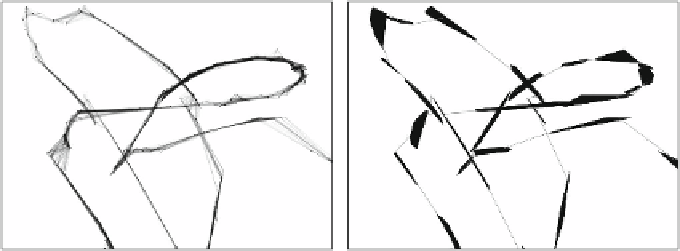Information Technology Reference
In-Depth Information
(a)
(b)
Fig. 2.
(a)Asectionofagraph, and (b) physics system representation
Edges, clustered edges, and bones:
If there is at least one edge between two clus-
ters
C
1
and
C
2
, then we say that
C
1
and
C
2
are
linked
.Iftwoclusters are linked, then
we place an elastic
bone
between them; physically this acts to approximately maintain
a specified distance between the two clusters. The bone has a
length
that defines this
distance. In GION, the length of a bone is held constant during asingle user operation,
but varies from one operation to the next, as explained below. The physics engine pro-
vides two parameters to define the elasticity of a bone:
frequency
and
damping ratio
.In
GION, the elasticity is held constant throughout.
3.2
User Operations
Users interact with the graph using the mouse to drag clusters into new positions. Each
GION user operation consists of three steps: 1) The user selects a node with a button-
down mouse event. 2) The user moves the mouse. Mouse movement is applied to the
physics simulation as a force that acts on the cluster containing the node selected by the
user. Using a force provides intuitive feedback about the connections from the selected
cluster; heavily connected clusters are more difficult (requiremoremouse movement)
to move than clusters with only a few connections. 3) The user releases (button-up) the
mouse. GION then re-sets the length of each bone to the distance between its endpoints.
GION differs significantly from previous skeletal animation methods in that the
length of each bone can vary from one user operation to the next. In a classical skeletal
animation (say of a human walking), bones have constant length; but GION introduces
some elasticity to the bone length. This provides more information to the user, as they
can more easily see how the graph is connected. However, we found through informal
pilot studies that users felt as though they did not have enough control over the layoutof
the graph. Users became frustratedwhenclusters, connected by constant length bones,
would rebound back towards their initial positions.
To improve this behaviour, GION resets all bone lengths when the user releases the
mouse. The distance between two clusters at that point in time becomes the new defined
distance for the bone: thustheclusters stay in their positions when the user releases the
mouse. This improves the control that users have over the layout. It also gives the users

